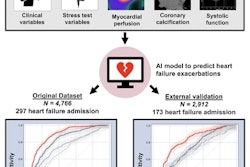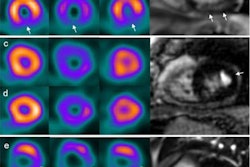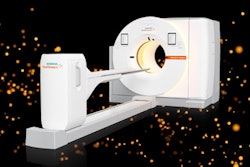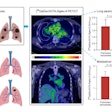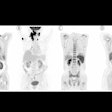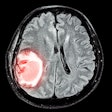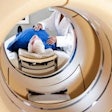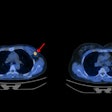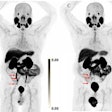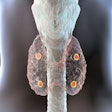SPECT/CT myocardial perfusion imaging (MPI) can identify patients with coronary artery disease (CAD) who are more likely to benefit from specific therapies, researchers have reported.
The study suggests that SPECT/CT MPI may have a role in guiding medical therapy for CAD, noted lead author Waseem Hijazi, MD, of the University of Calgary in Alberta, Canada, and colleagues.
“Our findings suggest that in addition to predicting risk of future cardiovascular event, hybrid SPECT/CT MPI findings may be helpful in guiding selection of medical therapies for CAD,” the group wrote. The study was published May 3 in the Journal of Nuclear Cardiology.
SPECT/CT MPI is one of the most widely used methods for diagnosing CAD due to its ability to detect areas of the heart with reduced blood flow (ischemia) and coronary artery calcium (plaque). In addition, previous studies have shown that SPECT/CT MPI can identify patients who may not do well with medical therapy alone and require revascularization, the authors noted.
Yet whether SPECT/CT MPI can help optimize medical therapy remains to be explored, the group wrote. To bridge the knowledge gap, the researchers evaluated the associations of beta-blockers, angiotensin converting enzyme inhibitors or angiotensin receptor blockers (ACEI/ARBS), and statins, prescribed within 180 days following SPECT/CT MPI, with survival in patients with suspected CAD.
The group identified 7,802 patients with known CAD who underwent technetium-99m sestamibi SPECT/CT MPI between January 2015 and December 2021. Patients underwent rest and stress imaging, with more than 95% undergoing one-day protocols and the remainder two-day protocols. Coronary artery calcium was also assessed using CT attenuation correction.
During median follow-up of 4.6 years, 1,265 (16.2%) patients died. The patients who survived over the follow-up period were younger (median age of 65.5 vs. 73.2), included a higher proportion of female patients, and had a lower prevalence of traditional cardiovascular risk factors.
 A graphical abstract of the studyJournal of Nuclear Cardiology
A graphical abstract of the studyJournal of Nuclear Cardiology
According to the analysis, beta-blockers were not associated with mortality overall, but were associated with lower mortality among patients with more ischemia on SPECT MPI (hazard ratio [HR], 0.94; p < 0.001).
Statin therapy was associated with reduced mortality when coronary artery calcium (CAC) was present and extensive on imaging (HR, 0.56; p < 0.001). When CAC was not assessed, there was no association between statin use and mortality (HR 1.16, p = 0.236). ACE/ARB prescription was also associated with reduced mortality when CAC was extensive (HR, 0.61; p < 0.001), the researchers reported.
“We demonstrated associations between statin, ACE/ARB, and beta-blocker therapy and survival over five years of follow-up that varied according to hybrid SPECT/CT findings in a contemporary cohort of patients,” the group wrote.
The researchers noted that the study is the first to demonstrate how SPECT/CT MPI may influence medical therapy and survival for patients evaluated for CAD and that the analysis reaffirms the importance of comprehensive medical therapy for these patients.
Coronary artery calcium burden by CT attenuation correction imaging could be used to identify the highest risk patients most likely to benefit from these medications, they suggested.
“Our findings support the role of SPECT MPI in combination with coronary artery calcification assessed on CT attenuation images to personalize medical management of patients with suspected CAD to optimize clinical outcomes,” the researchers concluded.
The full study can be found here.





